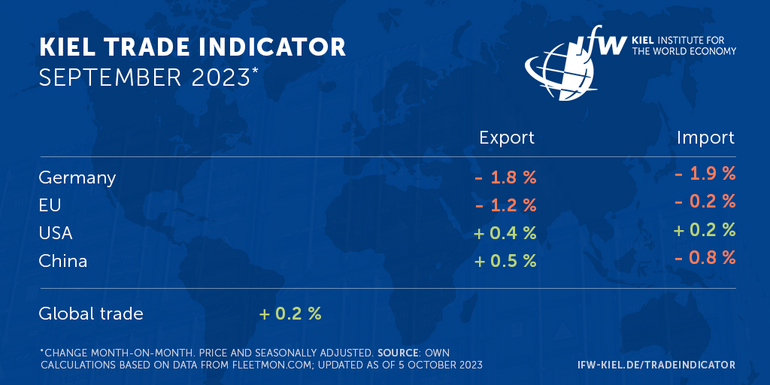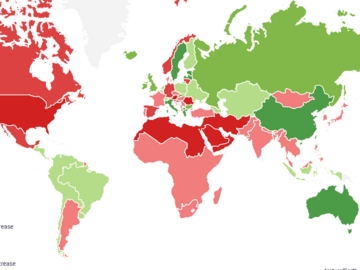News
Global trade feeble, freight rates sharply lower

The latest update of the Kiel Trade Indicator points to a sideways movement for global trade in September compared with the previous month of August, with an increase of 0.2 percent (price and seasonally adjusted).
For Germany, the September figures for both exports (-1.8 percent) and imports (-1.9 percent) are quite clearly in the red.
For the EU, the export figure (-1.2 percent) is also negative, while imports (-0.2 percent) are expected to be roughly at the previous month's level.
In the US, where economic activity in the third quarter is expected to be more positive than in the EU, exports (+0.4 percent) and imports (+0.2 percent) are slightly positive or moving sideways in September. China's exports (+0.5%) are expected to rise slightly compared with August, while imports (-0.8%) are expected to fall slightly.
"After the trade values of the Kiel Trade Indicator had turned out surprisingly positive for August, they are now pointing sideways again for the September trade flows. The downward countermovement is particularly pronounced in Germany," says Vincent Stamer, Head of Kiel Trade Indicator.
Freight rates drop significantly
Positive news for German exporters comes from sharply reduced freight rates, which have now fallen below the average of the years before the COVID-19 pandemic. In particular, on the transatlantic link to ports in the United States, the cost per container has fallen within a year from over 8,000 US dollars to just over 1,000 US dollars. During the pandemic, transport costs had skyrocketed.

"It is now significantly cheaper again for German exporters to ship goods. The chemical industry which currently suffers from high energy costs could benefit from this, since transport costs typically account for a large proportion of its trade value," says Stamer.
More goods on the move at sea, congestion declines
Overall, however, world trade is also showing signs of resilience following a weak year. The estimated volume of standard containers shipped globally jumped in September, significantly exceeding the 14 million mark. This is also due to the positive development of the previous month, as cargo shipped in August is likely to still be underway in September on many routes.
In addition, the economic development of the Asian emerging markets including China iscomparatively dynamic, countries there tend to use container ships as most preferred means of transport.

Congestion in container shipping is declining, with only a good 7 percent of all goods shipped worldwide currently stuck, an unremarkable figure by historical standards.

For more information on the Kiel Trade Indicator and forecasts for 75 countries and regions, visit www.ifw-kiel.de/tradeindicator.
The next update of the Kiel Trade Indicator will take place on November 7 for October trade data.
About the Kiel Trade Indicator
The Kiel Trade Indicator estimates trade flows (imports and exports) of 75 countries and regions worldwide, the EU and world trade as a whole. Specifically, the estimates cover over 50 individual countries as well as regions such as the EU, sub-Saharan Africa, North Africa, the Middle East or emerging Asia. It is based on the evaluation of ship movement data in real time. An algorithm programmed at the Kiel Institute uses artificial intelligence to analyze the data and translates the ship movements into price and seasonally adjusted growth figures compared with the previous month.
We update the data once a month around the 5th and then present the latest calculations for trade in the current and the previous month.
Arriving and departing ships are recorded for 500 ports worldwide. In addition, ship movements in 100 maritime regions are analyzed and the effective utilization of container ships is derived from draught information. Country-port correlations can be used to generate forecasts, even for countries without their own deep-sea ports.
Compared to previous leading trade indicators, the Kiel Trade Indicator is available much earlier, is much more comprehensive, relies on a uniquely large database using big data, and has a low statistical error by comparison. The algorithm of the Kiel Trade Indicator uses machine learning, so that the quality of the forecast continues to improve over time.

